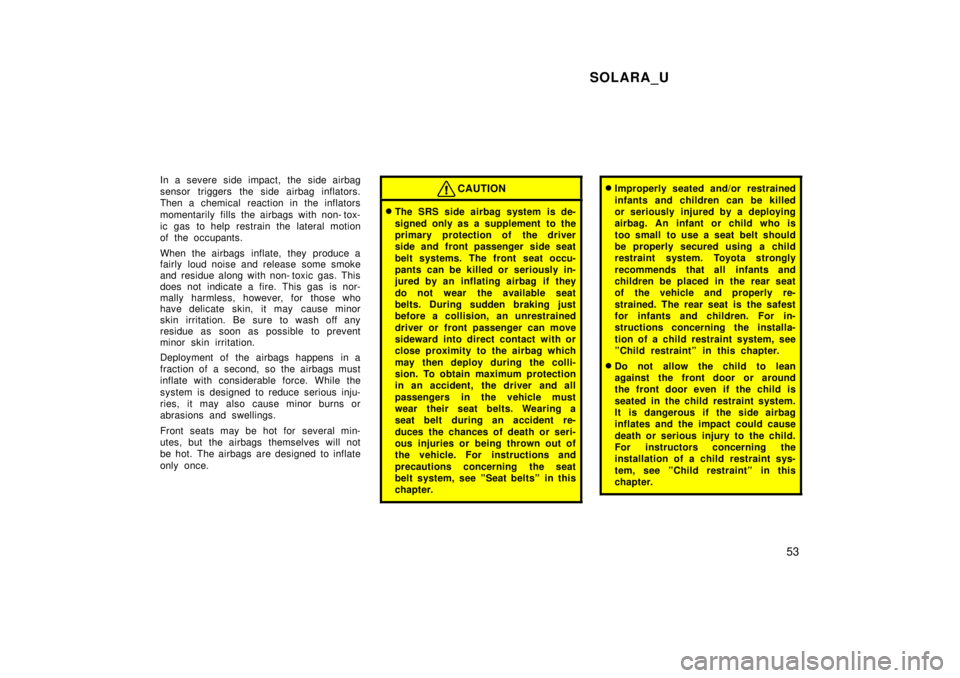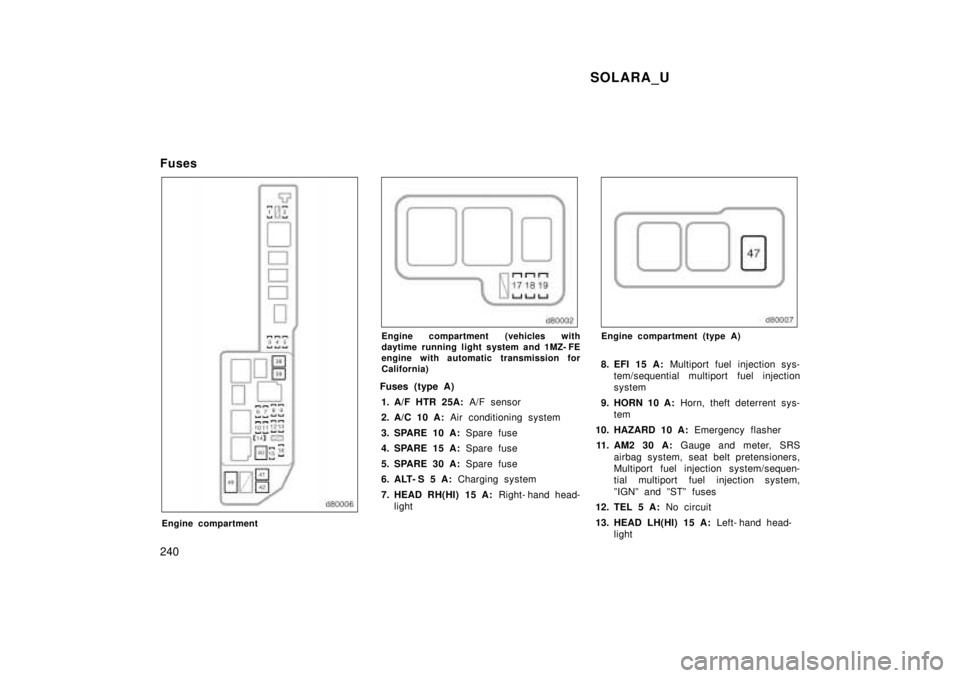1999 TOYOTA SOLARA sensor
[x] Cancel search: sensorPage 53 of 244

SOLARA_U53
In a severe side impact, the side airbag
sensor triggers the side airbag inflators.
Then a chemical reaction in the inflators
momentarily fills the air
bags with non- tox-
ic gas to help restrain the lateral motion
of the occupants.
When the airbags inflate, they produce a
fairly loud noise and release some smoke
and residue along with non- toxic gas. This
does not indicate a fire. This gas is nor-
mally harmless, however, for those who
have delicate skin, it may cause minor
skin irritation. Be sure to wash off any
residue as soon as possible to prevent
minor skin irritation.
Deployment of the airbags happens in a
fraction of a second, so the airbags must
inflate with considerable force. While the
system is desi gned to reduce serious inju-
ries, it may also cause minor burns or
abrasions and swellings.
Front seats may be hot for several min-
utes, but the airbags themselves will not
be hot. The airbags are designed to inflate
only once.
CAUTION
� The SRS side airbag system is de-
signed only as a supplement to the
primary protection of the driver
side and front passenger side seat
belt systems. The front seat occu-
pants can be killed or seriously in-
jured by an inflating airbag if they
do not wear the available seat
belts. During sudden braking just
before a collision, an unrestrained
driver or front passenger can move
sideward into direct contact with or
close proximity to the airbag which
may then deploy during the colli-
sion. To obtain maximum protection
in an accident, the driver and all
passengers in the vehicle must
wear their seat belts. Wearing a
seat belt during an accident re-
duces the chances of death or seri-
ous injuries or being thrown out of
the vehicle. For instructions and
precautions concerning the seat
belt system, see ºSeat beltsº in this
chapter.
�Improperly seated and/or restrained
infants and children can be killed
or seriously injured by a deploying
airbag. An infant or child who is
too small to use a seat belt should
be properly secured using a child
restraint system. Toyota strongly
recommends that all infants and
children be placed in the rear seat
of the vehicle and properly re-
strained. The rear seat is the safest
for infants and children. For in-
structions concerning the installa-
tion of a child restraint system, see
ºChild restraintº in this chapter.
� Do not allow the child to lean
against the front door or around
the front door even if the child is
seated in the child restraint system.
It is dangerous if the side airbag
inflates and the impact could cause
death or serious injury to the child.
For instructors concerning the
installation of a child restraint sys-
tem, see ºChild restraintº in this
chapter.
Page 85 of 244

SOLARA_U85
CAUTION
It is dangerous to continue driving
normally when the brake fluid level is
low.
If the brake fluid level is correct...
Have the warning system checked by your
Toyota dealer.
(b) Driver's Seat Belt Reminder Lightand Buzzer
Once the ignition key is turned to ºONº or
ºSTARTº, the reminder light and buzzer
come on if the driver's seat belt is not
fastened. Unless the driver fastens the
belt, the light stays on and the buzzer
stops after about 4 to 8 seconds.
(c) Front Passenger 's Seat Belt Re- minder Light
Once the ignition key is turned to ºONº or
ºSTARTº, the reminder light comes on if
a passenger sits in the front passenger
seat and does not fasten the seat belt.
Unless the front passenger fastens the
belt, the light stays on. This light reminds
you to backle up, the front passenger 's
seat belt. If luggage load is placed on the front
passenger seat, depending on its weight
and how it is placed on the seat, built- in
sensors in the seat cushion may detect
the pressure, causing the reminder light to
come on.
(d) Discharge Warning Light
This light warns that the battery is being
discharged.
If it comes on while you are driving, there
is a problem somewhere in the charging
system.
The engine ignition will continue to oper-
ate, however, until the battery is dis-
charged. Turn off the air conditioning,
blower, radio, etc., and drive directly to
the nearest Toyota dealer or repair shop.
NOTICE
Do not continue driving if the engine
drive belt is broken or loose.
(e) Malfunction Indicator Lamp
This lamp comes on in the following
cases.
a. The fuel tank is completely empty. (See
ºFuel gaugeº in Chapter 1- 5 for instruc-
tions.) b. The fuel tank cap is not tightened se-
curely. (See ºFuel tank capº in Chapter
1- 2 for instructions.)
c. There is a problem somewhere in your
engine or automatic transmission electrical
system.
If it comes on while you are driving in
case c, have your vehicle checked/re-
paired by your Toyota dealer as soon as
possible.
(f) Low Fuel Level Warning Light
This light comes on when the fuel level
in the tank becomes nearly empty. Fill up
the tank as soon as possible.
On inclines or curves, due to the move-
ment of fuel in the tank, the low fuel level
warning light may come on earlier than
usual.
(g) Low Oil Pressure Warning Light
This light warns that the engine oil pres-
sure is too low.
If it flickers or stays on while you are
driving, pull off the road to a safe place
and stop the engine immediately. Call a
Toyota dealer or qualified repair shop for
assistance.
Page 86 of 244

SOLARA_U
86
The light may occasionally flicker when
the engine is idling or it may come on
briefly after a hard stop. There is no
cause for concern if it then goes out when
the engine is accelerated slightly.
The light may come on when the oil level
is extremely low. It is not designed to
indicate low oil level, and the oil level
must be checked using the level dipstick.
NOTICE
Do not drive the vehicle with the
warning light onÐeven for one block.It may ruin the engine.
(h) ºABSº Warning Light
This light warns that there is a problem
somewhere in your anti- lock brake sys-
tem.
If the light comes on while you are driv-
ing, have your vehicle checked by your
Toyota dealer as soon as possible.
The light will come on when the ignition
key is turned to the ºONº position. After
a few seconds, the light will go off. When the ºABSº warning light is on (and
the brake system warning light is off), the
brake system operates conventionally but
anti- lock brake system is not assisting
brake performance so that the wheels can
lock- up during sudden braking or braking
on slippery road surfaces.
(i) Open Door Warning Light
This light remains on until all the doors
and back door are completely closed.
(j) Rear Light Failure Warning Light
If this light comes on when the headlight
switch is turned on (at the first or second
clickstop), it indicates that one or more of
the tail lights are burned out.
If it comes on when the brake pedal is
depressed, one or more stop lights are
burned out.
Have defective bulbs replaced as soon as
possible.
(k) SRS Airbag Warning Light
This light will come on when the igni-
tion key is turned to the ºACCº or
ºONº position. After about 6 seconds,
the light will go off. This means the
systems of the airbag and front seat
belt pretensioner are operating properly.The warning light system monitors the air-
bag sensor assembly, seat belt pretension-
er assembly, inflators, warning light, inter-
connecting wiring and power sources.
If either of the following conditions occurs,
this indicates a malfunction somewhere in
the parts monitored by the warning light
system. Contact your Toyota dealer as
soon as possible to service the vehicle.
� The light does not come on when the
ignition key is turned to the ºACCº or
ºONº position or remains on.
� The light comes on or flashes while
driving.
(l) Low Windshield Washer Fluid Level Warning Light
The light warns that the windshield washer
fluid level is too low. Add washer fluid at
your earliest opportunity. (For instructions,
see ºAdding washer fluidº in Chapter 7- 3.)
(m) ºTRAC OFFº Indicator/Warning Light
This light comes on when the ignition key
is turned to ºONº, and will go off after a
few seconds. This means that the system
is operating properly.
Page 239 of 244

SOLARA_U
240
Fuses
Engine compartment
Engine compartment (vehicles with
daytime running light system and 1MZ- FE
engine with automatic transmission for
California)
Fuses (type A) 1. A/F HTR 25A: A/F sensor
2. A/C 10 A: Air conditioning system
3. SPARE 10 A: Spare fuse
4. SPARE 15 A: Spare fuse
5. SPARE 30 A: Spare fuse
6. ALT- S 5 A: Charging system
7. HEAD RH(HI) 15 A: Right- hand head-
lightEngine compartment (type A)
8. EFI 15 A: Multiport fuel injection sys-
tem/sequential multiport fuel injection
system
9. HORN 10 A: Horn, theft deterrent sys-
tem
10. HAZARD 10 A: Emergency flasher
11. AM2 30 A: Gauge and meter, SRS
airbag system, seat belt pretensioners,
Multiport fuel injection system/sequen-
tial multiport fuel injection system,
ºIGNº and ºSTº fuses
12. TEL 5 A: No circuit
13. HEAD LH(HI) 15 A: Left- hand head-
light